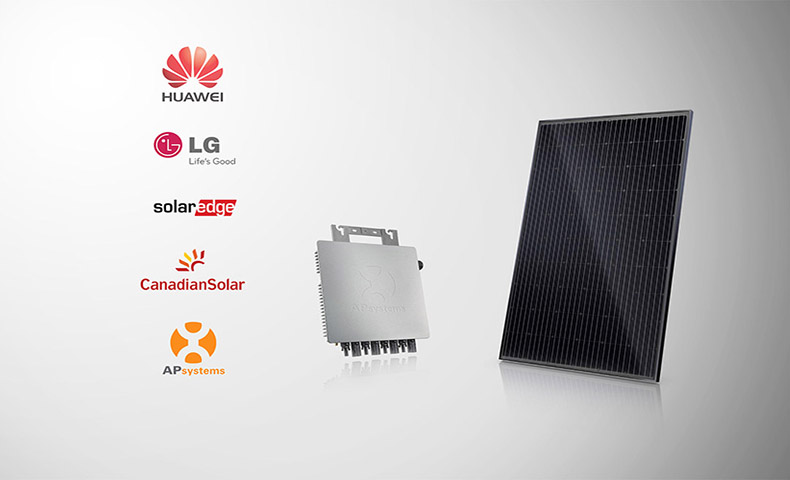
You’re getting ready to install solar panels, but aren’t sure about one of its main components, the inverter. They used to be only one kind, the string inverter that is still the most popular and widely-used type today, but there are now microinverters that are gaining in popularity.
In a domestic solar power system, the inverter is the mind of the installation and often plays a dual role. First and foremost, it changes the DC electricity created by the solar panels as they absorb sunshine into AC for use with your appliances, and they also repeatedly choose the optimal point on a power curve to maximize the amount of power that can be used.
Inverters also provide homeowners and installers with constant data on energy generation and other particulars, helping them identify and correct any problems that may arise.
The size of the inverter should match the maximum output of your residential solar panels to avoid “clipping” - when your inverter limits the amount of electricity going from your solar energy system into your household for use, because it reached its maximum capacity.
If you don’t know what the correct size of your solar power system should be, you can easily find out with the Hahasmart price checker. Just provide your address and your average monthly utility bill and you’ll get the actual price of solar panels and inverters - which are the most critical parts of a solar powered system - as well as provide you with an estimated cost of installation based on thousands of completed solar projects in your area.
They’ll even provide you with an estimated buyback period, the point where the electricity savings achieved with your solar array cover the purchase of your residential solar panels and your system becomes free.
In addition, they’ll connect you with their installer network to get your residence equipped with solar power as possible.
Now that you know what an inverter does, let’s find out which one is best for your situation?
Lots of space and nothing to block the sun
For the most part, residential solar installer with small projects will recommend using string inverters. They’re the most affordable ones and they work best when the panels are only covering one roof surface, in ideal energy production position, with nothing to block them from the sun.
Think of these as Christmas lights, where all the small light bulbs are attached to a string. Now replace those lights for solar panels. Different strings are associated with one string inverter. Each string conveys the DC power the panels produce to the string inverter where it's changed over into usable AC power.
String inverters can even handle a domestic solar power system installation stretched out on two roof surfaces that face different directions, provided there are no partial-shade issues.
Partial shade
Microinverters are small devices that do the DC-AC conversion right on each solar panels. They are the best option when your panels are partly shaded because each module is independent from the others. If shade affects a panel in a string, bringing down its energy output, it will impact the rest of the array.
The problem with stringed solar panels is that they operate at the production of the weakest panel connected. So when a chimney or branch casts a shadow on a corner of the array, the entire array’s production plummets.
For similar reasons if one panel fails, you can continue indefinitely with one less panel rather than needing to get somebody up to your roof to replace the failed panel.
Microinverters are slightly more expensive, but they also allow for easier upgrade of your domestic solar power system if you decide to add more panels later.
They are also best when you have solar arrays split in two or more different areas of the home and at different directions to the sun.
Shade appears after installation of your solar panels
Let’s say your neighbor’s tree hadn’t grown that much when you installed your solar panels, but now there’s a tree limb that throws shade over some of the panels in the middle of the day.
Your energy production is now suffering and your neighbor refuses to heed your calls to trim the tree.
When this happens, you have another option, power optimizers. Much like microinverters they attach to each individual solar panel to ensure that you are getting the most out of your system. They increase the output performance of each module at the individual level - which opens up a range of benefits for system owners.
Optimizers don’t work on their own. They work in tandem with the string inverter.
HahaSmart Blog - More Solar Tips and Guide
HahaSmart News - Stay Informed
Your Solar Incentives - See Credits and Incentives in Your Area
Check Your Home's Solar Price - See How Much You Save
Register Now - Unlock The Lowest Solar Prices in Your Area


Input your address to see if it is solar friendly and how much you can save with solar.
Great. Your address is perfect for solar. Solar incentive is still available. Select monthly utility cost and calculate the size of solar system you will need now.
| kw System size | years Payback period | Lifetime savings |
No money down, 100% finance is available.
|
|
Design the perfect solar system for your home in only a few minutes! |
Comments